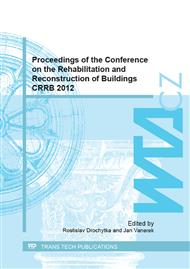[1]
H. Schorn, Betone mit Kunststoffen und andere Instandsetzungsbaustoffe, Verlag Ernst und Sohn, Berlin, (1991)
Google Scholar
[2]
R. Sasse et Al, Schutz und Instandsetzung von Betonbauteilen unter Verwendung von Kunststoffen, Sachstandsbericht, Deutscher Ausschuss für Stahlbeton, Heft 443, 1994.
Google Scholar
[3]
A. Dimmig-Osburg, A. Flohr, K. A.Bode, Der Einfluss von Polymermodifikationen auf das Verformungsverhalten und die Duktilität von Beton, 17. Internationale Baustofftagung ibausil, Bauhaus-Universität Weimar, Tagungsbericht – Band 1, S. 2-0093 bis 2-0107
Google Scholar
[4]
A. Dimmig-Osburg, Polymermodifizierte Mörtel (PCC) für die Sanierung, Europäischer Sanierungskalender 2010, Hrsg.: H. Venzmer
Google Scholar
[5]
W. Malorny, M. Puterman, Untersuchungen zur Gefügeentstehung und zum mechanischen Verhalten von polymermodifiziertem Beton, In: Schriftenreihe der FH Neubrandenburg, Fachbereich Bauingenieur- und Vermessungswesen, Band 7, 2004.
Google Scholar
[6]
M. Puterman, W. Malorny, Some Doubts and Ideas on the Microstructure Formation of PCC, 9th International Congress on Polymers in Concrete (ICPIC), Bologna, September 1998, p.165
Google Scholar
[7]
W. Bethge, T. Richter, Beton - Prüfung nach Norm, In: Schriftenreihe der Zement- und Betonindustrie, 2005, Hrsg.: BetonMarketing Deutschland GmbH, Erkrath
Google Scholar
[8]
Zement-Taschenbuch 2002, Hrsg., Verein Deutscher Zementwerke e.V. -VDZ-, Düsseldorf, 50. Ausg., VBT Verlag Bau u. Technik
Google Scholar
[9]
E DIN EN 1338:2010-08 (D), Pflastersteine aus Beton – Anforderungen und Prüfverfahren, Deutsche Fassung prEN 1338:(2010)
DOI: 10.31030/9496883
Google Scholar
[10]
M. J. Setzer, R. Auberg, Prüfvorschrift CIF-Test – Testmethode zur Bestimmung des Frostwiderstands von Beton, Referenzmethode und alternative Methoden A und B, In: Materials and Structures, November 2001, CIF-Test – Capillary suction, Internal damage and Freeze thaw Test, Reference method and alternative methods A and B
DOI: 10.1007/bf02482179
Google Scholar
[11]
Merkblatt Frostprüfung von Beton (BAW-Merkblatt Frostprüfung), Dezember 2004, Hrsg.: Bundesanstalt für Wasserbau Karlsruhe · Hamburg · Ilmenau
Google Scholar
[12]
L. Lohaus, L. Petersen, R. Griese, Beton mit hohem Säurewiderstand für den Kühlturmbau – eine Zwischenbilanz, Betontechnologische Grundlagen und Praxiserfahrungen, In: beton, Heft 9/2009, S. 370-379, Verlag Bau+Technik GmbH, Düsseldorf
Google Scholar


